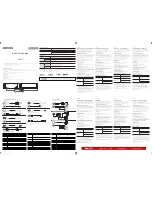
BA 5200 EN 08/2010
6.6.2
Demounting the shrink disk
•
Remove the protective cover.
•
Remove any rust deposits from the shaft and the hollow shaft.
Under no circumstances must the tensioning bolts be unscrewed one after the other.
•
Undo all tensioning bolts one after the other by approx. 1/4 turn.
The stored energy of the outer ring is slowly loosened during disassembly via the bolts to be
loosened. In order that this is carried out correctly, the procedure described here must be
carefully adhered to!
•
All tensioning bolts should now be further loosened one after the other by approx. 1 turn.
The outer ring should now release of its own accord from the inner ring. If this is not the case,
the outer ring can be detensioned with the forcing threads. To this purpose screw some of the
adjacent fastening bolts into the forcing threads. The now releasing outer ring is braced against
the remaining bolts. This operation must be carried out until the outer ring completely releases
of its own accord.
•
The shrink disk is to be secured against axial shifting.
•
Draw the stub shaft out of the hollow shaft.
•
Pull the shrink disk off the hollow shaft.
For transporting and lifting the shrink disk it may be required to use a suitable lifting
device!
6.6.3
Cleaning and greasing the shrink disk
Only dirty shrink disks must be disassembled and cleaned.
•
Inspection of all parts for any damage.
Damaged parts must be replaced with new ones! The use of damaged parts is not
permissible!
Only the complete shrink disks supplied by the manufacturer may be used. Combining
components from different shrink disks is not permitted.
•
Thoroughly clean all parts.
Do not use contaminated solvents or dirty cloths nor cleansing agents containing oil
(such as paraffin or turpentine) for removing grease.
•
The conical surfaces of the inner and outer rings (3 and 4, see Fig. 18) must be free of grease and oil.
─ A thin layer of grease must be applied evenly to the conical surfaces of the inner and outer rings
(3 and 4, see Fig. 18).
─ Provide the tensioning bolts (5, see Fig. 18) on the contact surface and on the thread with lubricant.
─ Use a solid lubricant paste with a
high MoS
2
based molybdenum disulphide content
which will
not slide during fitting work and which shows the following characteristics:
─ Friction coefficient "μ" = 0.04
─ resistant to pressure up to a maximum pressure of 300 N/mm
2
─ ageingresistant
















































